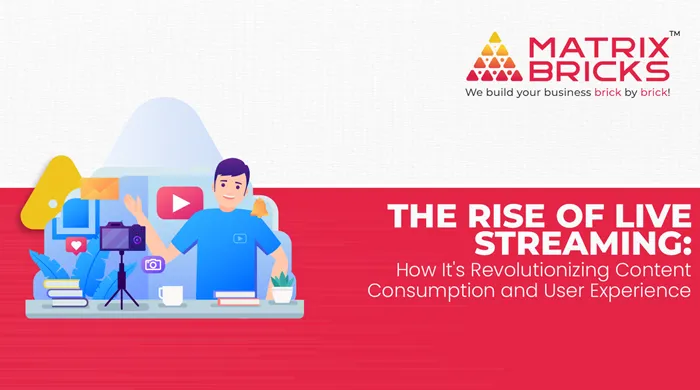
In recent years, the digital landscape has undergone a profound transformation, with live streaming emerging as a dominant force in the realm of content consumption. From entertainment and gaming to education and business, live streaming has revolutionized the way people engage with content online. In this blog post, we’ll explore the remarkable rise of live streaming and its impact on the user experience.

Understanding Live Streaming
Live streaming refers to the broadcasting of real-time video content over the internet. Unlike pre-recorded videos, live streams enable viewers to watch events as they happen, fostering a sense of immed iacy and connection. Whether it’s a product launch, a Q&A session with a celebrity, or a live tutorial, live streaming breaks down barriers between content creators and their audiences, allowing for direct interaction and engagement.
Live streaming, in its essence, involves broadcasting real-time video content over the internet. While the concept has been around for decades in various forms, it gained mainstream popularity with the rise of platforms like Twitch, YouTube Live, and Facebook Live. Initially dominated by gamers streaming their gameplay, live streaming quickly expanded to encompass a diverse range of content, including sports events, music concerts, educational seminars, and even everyday activities through platforms like Instagram Live.
Breaking Down Barriers
One of the key drivers behind the rise of live streaming is its ability to break down barriers between content creators and audiences. Unlike traditional media, where content is produced, edited, and distributed over a period of time, live streaming offers an unfiltered, real-time connection between creators and viewers. This immediacy fosters a sense of authenticity and intimacy, as viewers can interact with creators through live chat, comments, and reactions, creating a more immersive and engaging experience.
Redefining Content Consumption
Live streaming has redefined how we consume content, shifting away from passive consumption towards active participation. Instead of being mere spectators, viewers become part of the content creation process, shaping the direction of the stream through their feedback and interactions. This interactive element not only enhances engagement but also encourages community-building and fosters a sense of belonging among viewers.
Diversifying Content Formats
The versatility of live streaming has led to a proliferation of content formats, catering to a wide range of interests and preferences. Whether it’s live Q&A sessions, behind-the-scenes glimpses, or virtual events, live streaming offers endless possibilities for content creators to connect with their audience in new and innovative ways. This diversity not only keeps viewers engaged but also attracts new audiences who may be drawn to different types of content.
Amplifying User Experience
Live streaming has become synonymous with an enhanced user experience, offering features such as real-time interactions, multi-camera angles, and live polls that enrich the viewing experience. These interactive elements not only keep viewers engaged but also create a sense of anticipation and excitement, akin to attending a live event. Moreover, the ability to watch live streams on various devices, from smartphones to smart TVs, ensures accessibility and convenience for users, further amplifying the overall experience.
Fostering Community Engagement
Perhaps one of the most significant impacts of live streaming is its ability to foster community engagement. By providing a platform for like-minded individuals to come together and share their passion, live streaming creates virtual communities that transcend geographical boundaries. These communities often develop their own culture, language, and inside jokes, fostering a sense of belonging and camaraderie among members. In this way, live streaming becomes more than just a form of entertainment; it becomes a social experience that brings people together.
Driving Monetization Opportunities
With the growing popularity of live streaming comes a myriad of monetization opportunities for content creators. From sponsorships and brand partnerships to donations and subscriptions, creators can leverage their live streams to generate revenue in various ways. Platforms like Twitch and YouTube offer monetization features such as ads and channel memberships, while emerging platforms like Patreon allow creators to offer exclusive content and perks to their most dedicated fans. This monetization potential not only incentivizes creators to produce high-quality content but also enables them to turn their passion into a viable career.
Challenges and Considerations
Despite its many benefits, live streaming also poses some challenges and considerations, particularly in terms of moderation and content regulation. The live and unfiltered nature of live streams can sometimes lead to inappropriate or harmful content slipping through the cracks, requiring platforms to implement robust moderation tools and policies to maintain a safe and welcoming environment. Additionally, issues such as copyright infringement and digital rights management remain a concern, prompting platforms to adopt measures to protect intellectual property and ensure fair compensation for creators.

The Future of Live Streaming
As technology continues to advance and consumer preferences evolve, the future of live streaming looks brighter than ever. Emerging technologies such as virtual reality (VR) and augmented reality (AR) promise to further enhance the live streaming experience, offering immersive and interactive environments that blur the line between the virtual and the real. Moreover, the democratization of live streaming tools and platforms empowers anyone with a smartphone and an internet connection to become a content creator, ushering in a new era of creativity and expression.
Conclusion
In conclusion, live streaming has emerged as a powerful force in the world of digital content consumption, revolutionizing the way we engage with media and interact with each other. By offering real-time experiences, fostering community engagement, and driving monetization opportunities, live streaming has transformed the way we consume, create, and share content. As technology continues to evolve and innovation continues to thrive, the future of live streaming holds endless possibilities, promising to redefine the way we connect and communicate in the digital age.





